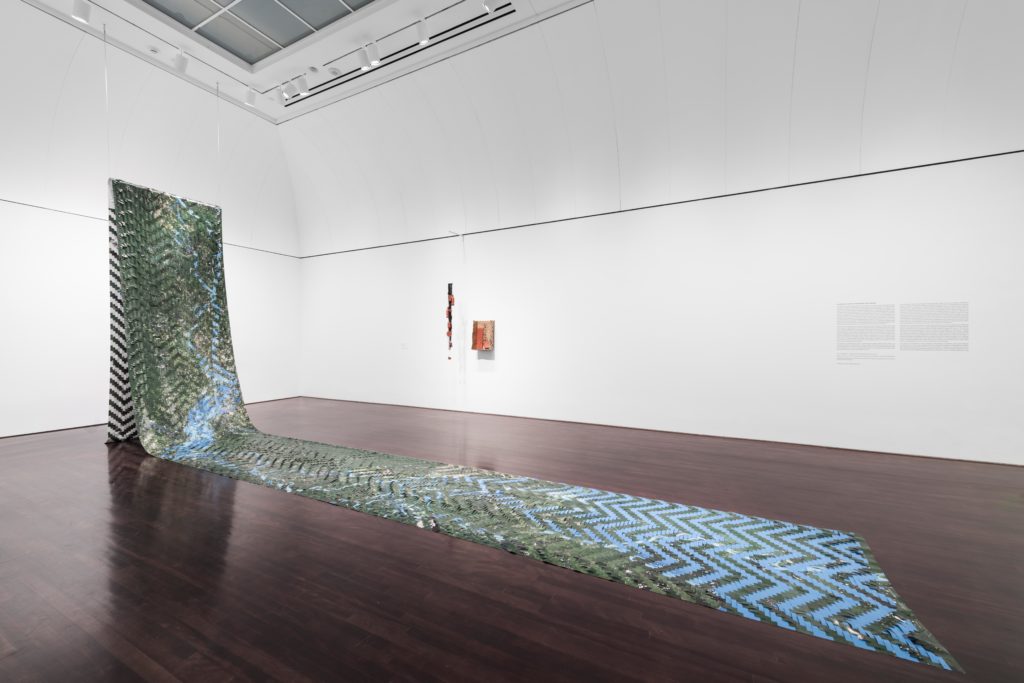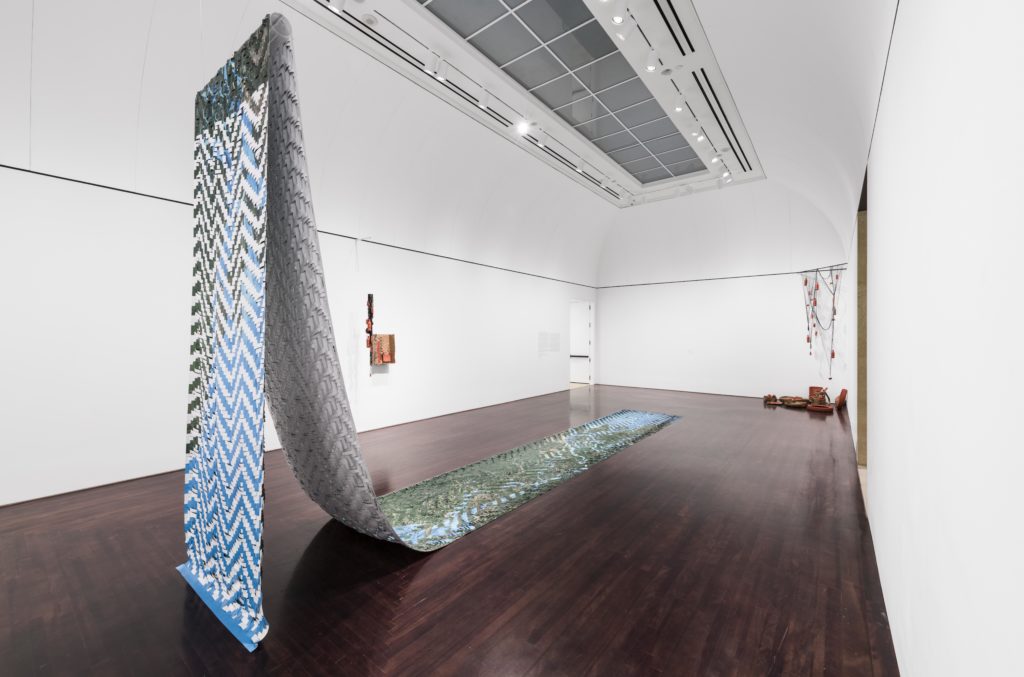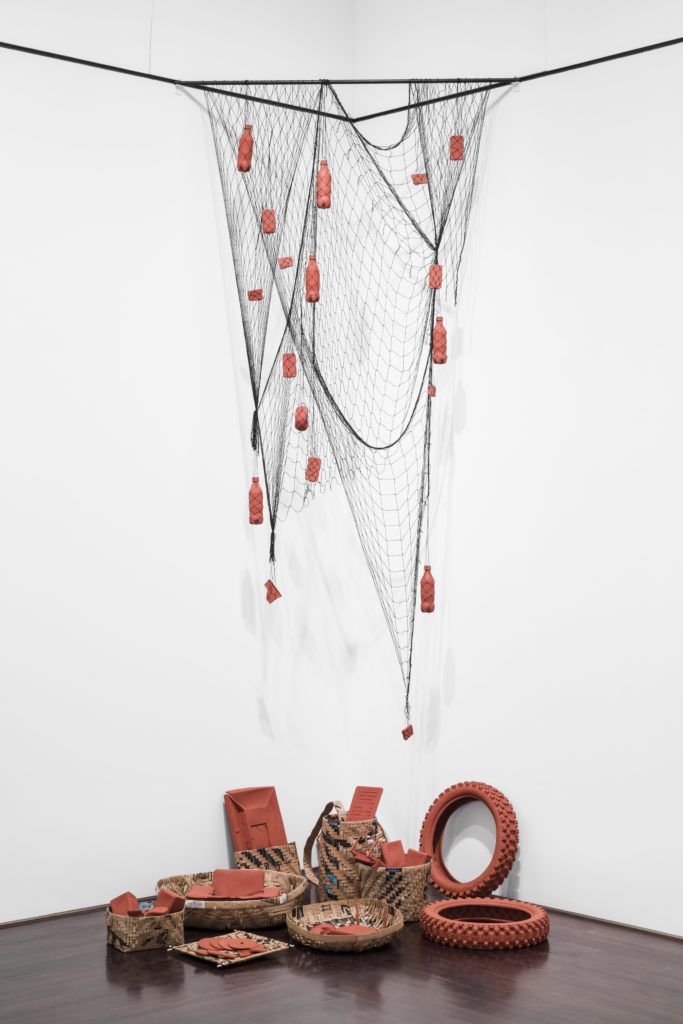
Where does our e-waste—smartphones, keyboards, and Wi-Fi routers—end up after arriving at the dump? Eighty percent of it is deconstructed, and the process of retrieving its usable metals is typically extremely toxic, part of it continues on to the Pacific Garbage Patch—a large area of floating plastic and trash located halfway between Hawaii and California—and part of it goes back into our food.1 This circulation of goods is what Clarissa Tossin’s exhibition, Encontro das Aguas [Meeting of Waters] expands upon. Located in a large rectangular room at the Blanton Museum in Austin, Texas, Encontro das Aguas is the title of both the featured tapestry, as well as the namesake of the exhibition as a whole. The tapestry has a looming presence at fifty feet long by four and a half feet wide.2 It captures the passage of consumption and production within the Amazon, which includes the river, the forest, and the eponymous company. The tapestry is woven out of satellite imagery depicting the meeting place of the Upper Amazon River—also known as the Solimões—and the Rio Negro, a location of nearly four miles where the two bodies of water converge but remain separate. The speed of the current, and the differing densities of salt and mineral composition keep the two rivers distinct. The Solimões gets its tan color due to the sediment eroded from the Andes Mountains and the Rio Negro derives its black color from physical erosion of rock and organic matter from the forest.3 This simultaneous separation and cohesion is echoed in the installation, where the warp and weft of the tapestry separate and highlight the texture of sky blue, earthly green and white color fields.4
One end of the tapestry is hoisted up to the ceiling on a beam, while the other side splays out across the gallery floor like a long throw rug. The satellite imagery depicts the nine-hundred-mile stretch between the mouth of the Amazon river, where it begins to flow into the Atlantic Ocean, and the port city of Manaus—the exact stretch that cargo ships traverse to access the Free Trade Zone.”5 In the nineteenth century, British investment made Manaus the center of the rubber boom due to a monopoly. However, after seeds were smuggled out of Manaus, the British turned to their own colonies and began growing cheaper rubber in places like Malaysia and Sri Lanka. This left the city of Manaus economically stagnated.6 In 1967, it became a Free Trade Zone in an effort to encourage business in the city. Tax exemptions and a “near obliteration of deforestation laws” regarding the Amazon rainforest, led to companies such as Apple, Sony, LG, Coca-Cola, Panasonic, Honda motorcycles and Harley Davidson opening production plants there.7

Tossin’s satellite imagery of the Solimões and the Rio Negro has been cut into strips and woven together. The pixelated imagery reduces the detail of the image, and simultaneously highlights the way land and sea are woven in opposite directions to one another, mimicking the upward and downward route of goods, materials, and people on the Amazon river. Lush Amazon forest becomes an abstracted patchwork of dark and light green, with a speckling of white and tan colors; the river becomes flowing streaks of light and sky blue. The pattern miniaturizes a large swath of land and sea that humans usually visit as a tourist site, a destination heightened to mythic proportions due to naturally occurring meeting of waters of the Rio Negro and Solimões. Its topography is glitched, artifacted, and reassembled through the technological production of weaving. The tapestry shows the linkage of the port city of Manaus to globalization, the impact of industrialization, the landscape, and to the material culture of the indigenous Baniwa people of the Brazilian Amazon.
This history is also reflected in the two installations tucked in the corner against the wall called Nova Gramática de Formas [New Grammar of Forms] Nos. 1-3. Baskets and cups woven out of Amazon.com cardboard boxes reference traditional handicraft of the Baniwa people, while the material itself—an entity too often relegated to the trash after the object within has been consumed—references a contemporary mode of shipping.

Terracotta objects traditionally made from plastic such as keyboards, CDs, Wi-Fi routers, tires and printers are entangled as if harnessed from the sea like a catch of the day, the black netting referencing the historical role of fishing in the coastal city. This assemblage places these objects precariously within the black netting; they are made from the clay, fragile and require care to preserve much like the ecology of natural forest and trees of the Amazon forest. While they lack the functionality of their plastic counterparts, the terracotta electronics are still caught “in the web” of big data, surveillance, and targeted Ads just as much as customers of the big four, Facebook, Google, Apple, and Amazon.8 In the frenzy facilitated by the cycle of production and consumption, Tossin asks us to pause and contemplate the historical ramifications of how companies like Amazon navigate the distance between the port of Manaus, the accumulation of electronic waste and our doorsteps.
Clarissa Tossin: Encontro Das Águas (Meeting of Waters) runs at the Blanton Museum of Art in Austin, TX until July 1, 2018.
- Staff, NPR. “After Dump, What Happens To Electronic Waste?” NPR, NPR, 21 Dec. 2010, www.npr.org/2010/12/21/132204954/after-dump-what-happens-to-electronic-waste.
- JOAN – Los Angleles. “Clarissa Tossin: Encontro Das Águas (Meeting of the Waters).” JOAN, JOAN, 19 Mar. 2017, joanlosangeles.org/clarissa-tossin/.
- Administrator, NASA Content. “Solimões and Negro Rivers.” NASA, NASA, 10 Mar. 2016, www.nasa.gov/multimedia/imagegallery/image_feature_577.html.
- Maguire, T. C., 2012. The Amazon Handbook 2nd Ed.,
- “Clarissa Tossin: Meeting of Waters.” Austins Blanton Museum of Art, blantonmuseum.org/rotation/clarissa-tossin-meeting-of-waters/.
- Associated , et al. “Welcome to Manaus, a Factory City in the Heart of the Jungle.” The Conversation, The Conversation, 16 May 2018, theconversation.com/welcome-to-manaus-a-factory-city-in-the-heart-of-the-jungle-27750.
- Presidency of the Republic (February 28, 1967). “Decree-Law. 288 of 28 February 1967” (in Portuguese). Civil House; Subheading for Legal Affairs.
- Galloway, Scott. FOUR: the Hidden Dna of Amazon, Apple, Facebook, and Google. Portfolio Penguin, 2018.